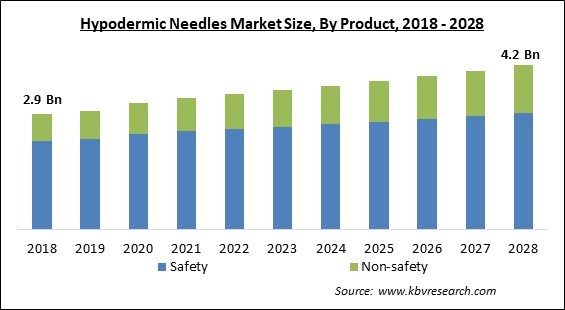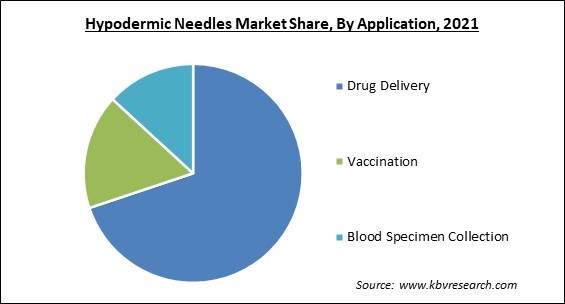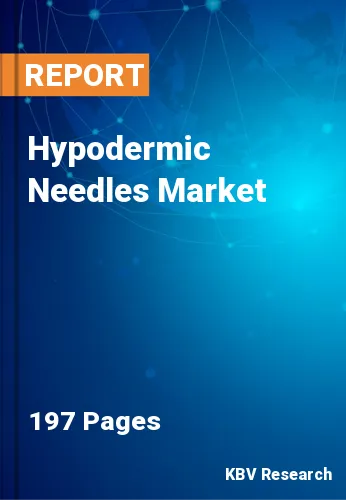The Global Hypodermic Needles Market size is expected to reach $4.2 billion by 2028, rising at a market growth of 3.3% CAGR during the forecast period.
A hypodermic needle is a cylindrical hollow needle that is commonly used in medical settings for a variety of purposes, including medicine vaccination, delivery, and blood specimen collection. These needles have two types of mechanisms viz. safety and non-safety needles. They are used to give and inject medications into the body, as well as to remove bodily fluids for analysis and research.
The rise of the hypodermic needles industry is fueled by the rising frequency of chronic infectious disorders like Hepatitis B and C. According to the World Health Organization, in 2019, 296 million individuals were estimated to have chronic hepatitis B infection, with 1.5 million new cases per year. Hepatitis B caused an estimated 820,000 fatalities, and hundreds of thousands of healthcare professionals were exposed to contaminated needle sticks or sharp injuries, putting them at risk for work-related illnesses such as hepatitis B, hepatitis C, and HIV. Furthermore, hypodermic needles are utilized to administer vaccines to patients during vaccination. According to the Organization, a total of 11,324,805,837 COVID-19 vaccine doses had been provided worldwide as of April 17, 2022, which is anticipated to boost demand for hypodermic needles.
The market is estimated to rise due to an increase in the incidence of chronic and lifestyle illnesses, particularly an increase in the prevalence of diabetes worldwide, technological improvements in the hypodermic needles industry, and increased demand for improved hypodermic needles solutions. In addition, the increase in the demand for hypodermic needles, as well as rising disposable incomes and growth prospects in various countries, are likely to create several prospects for the hypodermic needles market. Furthermore, the increasing prominence of key manufacturing businesses that produce and distribute hypodermic needles, as well as an increase in healthcare spending, are driving the growth of the hypodermic needles market

The COVID-19 pandemic caused severe harm to various businesses all over the world. The outbreak of the pandemic significantly disrupted various economies all over the world. In the initial period of the COVID-19 spread, several markets witnessed a shortage of labor and workforce. In addition, to regulate the rapid spread of the COVID-19 infection, governments across the world were compelled to impose a lockdown in their countries. The lockdown scenario led the worldwide economy to the closure of several companies and manufacturing units of numerous goods and services. Moreover, worldwide governments also enforced stringent travel restrictions in their countries, due to which, there was a major disruption in the global supply chain. As a result, lockdown and supply chain disruption caused generated a significant demand-supply gap in the market.
Because of the reduced risk of infection or contamination, hypodermic needles are becoming very popular all over the world. Since every hypodermic needle is entirely smooth, airborne pathogens have a harder time settling on it. Another rationale for the low risk of contamination is the needle's small diameter, which creates a very small hole when penetrating a vein. This function of the hypodermic needle significantly aids in the reduction of pain for the patient. Moreover, it can also aid in the prevention of infection because fewer germs or microbes would be able to penetrate the body through the tiny perforation.
With rapid urbanization and modernization, the lifestyle of people all over the world is rapidly evolving. One of the major changes in the lifestyle of people is the adoption of a sedentary lifestyle due to extended working hours along with the hectic lifestyle of people. Due to this transition, the number of people with various chronic diseases is rising. In the modern era, the food consumption of people has been significantly altered by junk food and other unhealthy edibles. Diabetic is a major risk factor that is associated with this lifestyle of people. Due to the increased sedentary lifestyle among people, the rate of obesity all over the world is increasing. Obesity is one of the most prevalent factors that cause diabetes in people.
Hypodermic needles are extremely helpful in the entire healthcare setting as it considerably streamlines the process of injecting any medicine into the body of a patient through their vein. However, there is a major impeding factor that is hindering healthcare professionals from leveraging hypodermic needles. Trypanophobia is an irrational and extreme fear of medical treatments involving needles. It's linked to phobias of needles, pins, and other sharp items. Patients that are suffering from this phobia are extremely afraid of any kind of needle that is being used in both medical and non-medical settings. People with trypanophobia experience severe anxiety when they see or hear about a needle operation.

Based on Product, the market is segmented into Safety and Non-safety. In 2021, the safety hypodermic needles segment acquired the largest revenue share of the hypodermic needles market. The increasing growth of the segment is owing to the developments in R&D activities across the healthcare sector as well as an increase in the occurrence of needlestick injury. Because of the ease and safety that these goods provide, safety hypodermic needles are broadly adopted among customers all over the world. Luer lock, single-handed technique along with other safety features is included in safety hypodermic needles.
Based on Application, the market is segmented into Drug Delivery, Vaccination and Blood Specimen Collection. In 2021, the vaccination segment recorded a significant revenue share of the hypodermic needles market. For immunization processes, hypodermic needles of various sizes can be used. The gauge refers to the needle tubing's outer diameter. The smaller the needle's diameter, the higher the gauge number. Many vaccines are advised for intramuscular injection, while others can also be given subcutaneously or intradermally. Choosing the right needle length and gauge can help ensure that vaccination is delivered to the right place and creates the best immune response while causing the least amount of harm.
Based on End Users, the market is segmented into Hospital, Diabetic Patients, Family Practitioners, Psychiatry and Others. In 2021, the hospitals segment witnessed the largest revenue share of the hypodermic needles market. The increasing growth of the segment is attributed to the rising demand for minimally invasive surgeries Hypodermic needles are commonly used in hospitals for a variety of purposes, including immunization, medicine delivery, blood sample collection, and more. In addition, hospitals in wealthy countries have made the use of hypodermic needles mandatory. To avoid the spread of blood-borne infections like hepatitis, HIV, and viral hemorrhagic fevers, the World Health Organization (WHO) has advised all healthcare practitioners to switch to safer needles.
| Report Attribute | Details |
|---|---|
| Market size value in 2021 | USD 3.3 Billion |
| Market size forecast in 2028 | USD 4.2 Billion |
| Base Year | 2021 |
| Historical Period | 2018 to 2020 |
| Forecast Period | 2022 to 2028 |
| Revenue Growth Rate | CAGR of 3.3% from 2022 to 2028 |
| Number of Pages | 197 |
| Number of Tables | 196 |
| Report coverage | Market Trends, Revenue Estimation and Forecast, Segmentation Analysis, Regional and Country Breakdown, Companies Strategic Developments, Company Profiling |
| Segments covered | Product, Application, End Users, Region |
| Country scope | US, Canada, Mexico, Germany, UK, France, Russia, Spain, Italy, China, Japan, India, South Korea, Singapore, Malaysia, Brazil, Argentina, UAE, Saudi Arabia, South Africa, Nigeria |
| Growth Drivers |
|
| Restraints |
|
Based on Regions, the market is segmented into North America, Europe, Asia Pacific, and Latin America, Middle East & Africa. In 2021, Asia-Pacific accounted for the largest revenue share of the hypodermic needles market. The rapidly increasing growth of the regional market is attributed to an increase in the prevalence of chronic diseases, the presence of a large population base (with India and China being two of the most populated countries), the presence of unmet medical needs, an increase in people's disposable incomes, and a rise in awareness about the utilization of hypodermic needles in the region.
Free Valuable Insights: Global Hypodermic Needles Market size to reach USD 4.2 Billion by 2028
The market research report covers the analysis of key stake holders of the market. Key companies profiled in the report include Becton, Dickinson and Company, Terumo Corporation, Nipro Corporation, Cardinal Health, Inc., B. Braun Melsungen AG, McKesson Corporation, Retractable Technologies, Inc., Connecticut Hypodermics, Inc., Exelint International, Co., and i-Tech Medics Private Limited.
By Product
By Application
By End User
By Geography
The global hypodermic needles market size is expected to reach $4.2 billion by 2028.
Rising number of diabetic patients all over the world are increasing are driving the market in coming years, however, increasing cases of trypanophobia growth of the market.
Becton, Dickinson and Company, Terumo Corporation, Nipro Corporation, Cardinal Health, Inc., B. Braun Melsungen AG, McKesson Corporation, Retractable Technologies, Inc., Connecticut Hypodermics, Inc., Exelint International, Co., and i-Tech Medics Private Limited.
The Drug Delivery segment acquired maximum revenue share in the Global Hypodermic Needles Market by Application in 2021, thereby, achieving a market value of $2.84 billion by 2028.
The Asia Pacific is fastest growing region the Global Hypodermic Needles Market by Region in 2021, and would continue to be a dominant market till 2028.
Our team of dedicated experts can provide you with attractive expansion opportunities for your business.

